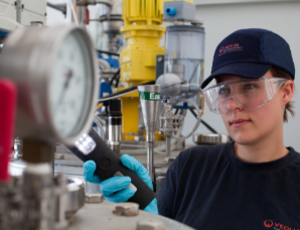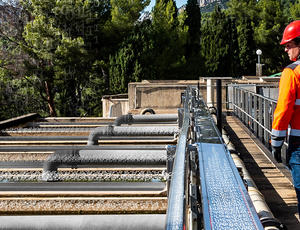The new generation of water purification systems, designed for life sciences and pharmaceutical research.
Overview
Water is the most commonly used solvent in laboratories, whether for research or analytical activities. We understand the need for precision in the results obtained. The Purelab® Flex range gives you access to ultrapure water. It meets the needs of researchers by providing accurate results while remaining user-friendly and flexible thanks to its innovative and ergonomic design
What is the new Purelab Flex?
Next-generation water purification for your laboratory
Purelab Flex is an innovative and flexible addition to the Purelab range. It provides consistently high water purity along with economical and effortless operation and maintenance.
With a clear display, simplified maintenance, real-time total organic carbon (TOC) monitoring, and prioritized information, high-quality results are consistently achieved.
Significantly reduced environmental impact
- A new high-performance reverse osmosis (RO) membrane reduces water waste by 20%.
- Eco-mode coupled with reverse osmosis (RO) module reduces energy consumption by up to 55%.
- Made from up to 70% recycled materials.
Typical applications for Purelab Flex:
- Chromatography (e.g., HPLC, UPLC, LC-MS, IC)
- Mass spectrometry
- Genomics (e.g., PCR, DNA)
- Proteomics (e.g., crystallography, electrophoresis)
- Immunology (monoclonal antibody production)
- Pharmacology
- Molecular biology and microbiology
- Immunochemistry
- Spectrophotometry

Features and Benefits

Provides a reliable supply of Type 1 water

Real-time TOC monitoring

Full recirculation for pure water at the point of use

Bench or wall-mounted installation for space-saving

Simplified maintenance

70% recycled materials

20% reduction in wastewater

Up to 55% reduction in energy used
Applications
Services
Resources & Product range
Meet the full Purelab Flex range:
- Purelab® Flex 1: A versatile dispensing and monitoring system when connected to a reservoir or distribution loop, while also functioning seamlessly as a straightforward deionization system.
- Purelab® Flex 2: generates ultrapure type I (18.2 Ω.cm) water from a pre-purified source, making it perfect for analytical and life science purposes.
- Purelab® Flex 3: provides ultrapure water from potable tap water in one single unit.
- Purelab® Flex 3+: A unique automated solution providing Type I (ultrapure water) from potable water. Couples directly with analytical chemistry systems delivering complete automation in one single unit.
Contact
Purelab Flex allows researchers to focus on their scientific work thanks to its effortless operation and maintenance. It also helps, laboratories improve their sustainability by reducing energy, wastewater and materials contributing to a greener future for scientific research.
Malte Sadetzky
Sales manager Elga Labwater, Veolia Water Technologies
FAQ about Purelab Flex
What are the different types of laboratory water purification systems?
Laboratory water purification systems include reverse osmosis (RO), deionization (DI), ultrafiltration (UF), and distillation. Each type is designed to remove specific contaminants to meet the purity requirements of various applications.
What quality controls are performed on purified water?
Quality controls for purified water include monitoring parameters such as resistivity, total organic carbon (TOC), microbial contamination, and particulate levels. These measures ensure the water meets the required purity standards for laboratory applications.
What quality controls are performed on the purified water?
The Purelab Flex features continuous monitoring of key parameters such as conductivity, resistivity, and total organic carbon (TOC). Alarms are triggered if any deviations occur to ensure water consistently meets the required specifications. Additional tests for endotoxins, RNases, DNases, etc., can also be performed.
What is total organic carbon (TOC) and why is it important in water purification?
Total organic carbon (TOC) is a measure of organic contaminants in water. It is important in water purification because high TOC levels can interfere with sensitive laboratory analyses and affect the accuracy of experimental results. Monitoring TOC ensures high water quality.
How can laboratories reduce their environmental impact when using water purification systems?
Laboratories can reduce their environmental impact by choosing water purification systems with eco-friendly features, such as reduced water waste, lower energy consumption, and systems made from recycled materials. Implementing water-saving practices and regular maintenance also contributes to sustainability.
Case studies

To meet the ultrapure water needs essential for their students' analytical practices, a vocational college adopted the Purelab Flex. Thanks to its flexible and modular design, this system provides a consistent supply of ultrapure water, indispensable for the analytical techniques taught, such as AAS, HPLC, GC, GC-MS, and ICP-OES. Students can now train on state-of-the-art equipment, replicating the conditions of the most demanding research laboratories.







